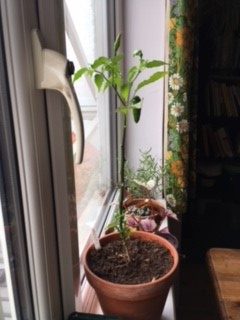
We have an evictee from the greenhouse. This is chilli ‘Lemon Drop’, who was sown too late to ever really amount to anything, and so – fair enough – went on to do little. You can see that chillies are now starting to form, but this is not exactly a bumper crop. However it could produce one next year. Chillies are mostly treated as annual plants partly because they are killed off by our cold winter weather and partly because it fits in with the rest of our annual-style of growing, but they are not annuals. They are perennials, and with a little bit of care they can be nurtured through the cold and dark months and be ready to leap back into life next spring. This has the benefit that they are then raring to go, and with a big, healthy root system already established and the whole growing season ahead of them, as opposed to newly sown chillies that have to do all of that establishing growth before they can even begin. The overwintered chilli could start into flower and then into fruit much earlier in the year. A bumper crop could be ours after all.
You will notice that the operative word here is ‘could’, and this is because this is a not a straightforward thing to do, it bit of a tricky manoeuvre. Ideally the plant needs to go into a state of suspended animation so that it wakes up raring to go, rather than puttering on weakly all through winter, and it’s hard to hit that sweet spot. Growth all winter would lead to the plant becoming drawn out in the low light, and the subsequent soft, sappy growth would be prey to sap sucking aphids and scale insects. Come spring the plant would be in no great state. So the ideal spot would be relatively cool, to prevent this: a slightly heated greenhouse or a porch or conservatory that stays cool but frost free. An unheated spare room would be good too, but how many of us have one of those? Our solution is to have it in the kitchen for now and then move it out into the mini greenhouse alongside the house once the heating goes on in earnest and then to hope for the best.
There are a few things to do to give your chilli plant the best chance of overwintering. First, check all over for pests or disease, particularly sneaky sap suckers that can hide in creases and stem joints. Wipe aphids off with finger and thumb, or if you see scale insects you may have to remove them with a cotton bud dipped into white spirit, to break down the waxy coating. Then – painful as it will be to do so – it is also a good idea to cut the plant back. It has taken so long to reach this point but we don’t want the plant wasting energy on trying to maintain green leaves all winter and chopping back will encourage a dormant state. And so as soon as that little chilli shows some colour I am harvesting and chopping. Cut the plant right back leaving about 15cm of stem and take off all side shoots too. It is also a good idea to repot now, again to make sure that there are no lingering pests. Shake all of the soil off of the rootball and repot into a small pot of fresh compost. Then you just need to give the plant a little trickle of water every few weeks until spring. When the weather warms I will increase water a little and watch for growth (it may be slow, be patient), and then pot on into a bigger pot and hopefully watch my chilli plant take off and finally provide me with that good, early crop of Lemon Drop chillies.


